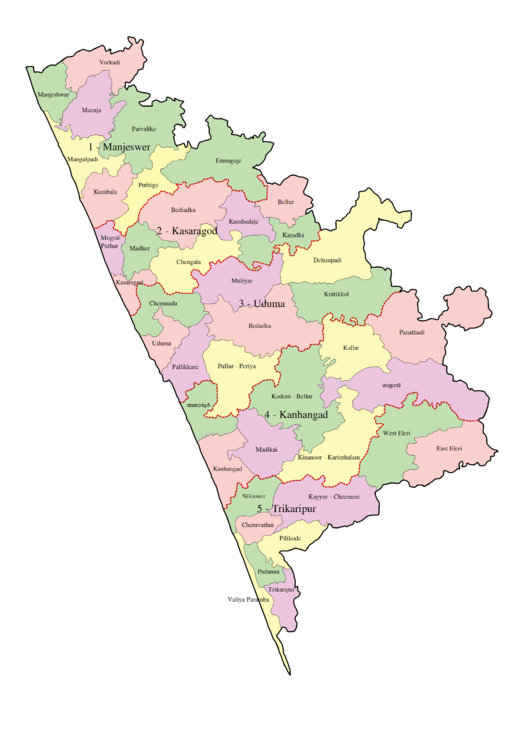Kasaragod: The Hidden Gem of Kerala’s Rich Culture and Natural Beauty
Kasaragod, located in the northernmost region of Kerala, India, is a town steeped in history, cultural diversity, and scenic beauty. Known as the “Land of Seven Languages” due to the linguistic diversity in the region, Kasaragod is a perfect blend of nature’s wonders, historical landmarks, and religious significance. From its breathtaking beaches and forts to its rich historical legacy, Kasaragod is a treasure trove for travelers seeking an off-the-beaten-path destination in Kerala.
How to Reach Kasaragod
By Bus:
An excellent network of roads connects Kasaragod to major towns in Kerala, Karnataka, and Tamil Nadu. Kasaragod KSRTC Bus Station is a hub for inter-state and inter-district travel.
- KSRTC Bus Station Contact: +91 499 423 0677
By Flight:
The nearest airport to Kasaragod is in Mangalore, approximately 69 km away, offering regular flights to major Indian cities. Alternatively, Calicut International Airport is located about 200 km from Kasaragod.
By Train:
Kasaragod is well-connected by rail. The Kasaragod Railway Station is situated on the Kozhikode-Mangalore-Mumbai route, making it easily accessible by train from other major cities.
Kasaragod: Key Information
| Attribute | Details |
|---|---|
| Country | India |
| State | Kerala |
| District | Kasaragod |
| Taluk | Kasaragod, Manjeshwar, Hosdurg, Vellarikundu |
| Government Type | Municipal Corporation |
| Municipal Body | Kasaragod Municipal Corporation |
| District Collector | Inbasekar K IAS |
| Sub Collector & RDO Kanhangad | Prateek Jain IAS |
| District Police Chief | Shilpa Devaiah |
| MP (Member of Parliament) | Rajmohan Unnithan (Kasaragod) |
| Members of Legislative Assembly | M Rajagopalan (Trikaripur MLA) |
| N.A Nellikkunnu (Kasaragod MLA) | |
| C H Kunhambu (Udma MLA) | |
| E Chandrasekharan (Kanhangad MLA) | |
| A K M Ashraf (Manjeshwar MLA) | |
| Languages Spoken | Malayalam, Kannada, Tulu, Beary, Konkani, Urdu, Hindi |
| Nearest Airport | Mangalore International Airport (69 km), Calicut International Airport (200 km) |
| Railway Station | Kasaragod Railway Station (Southern Railway Zone) |
| Bus Station | Kasaragod KSRTC Bus Station (+91 499 423 0677) |
| Nearby Districts | Kannur, Wayanad, Mangalore, Kozhikode, Udupi |
| Famous Food | Kozhi Curry, Meen Curry, Neer Dosa, Appam, Kotte Kori |
| Speciality | Coastal seafood, Local spices, Traditional crafts |
| Tourist Attractions | Bekal Fort, Chandragiri Fort, Ranipuram, Valiyaparamba Beach, Ananthapuram Lake Temple |
| Best Time to Visit | October to March |
Where is Kasaragod?
Kasaragod is a vibrant municipal town and the administrative headquarters of the Kasaragod district. Positioned strategically between Kerala’s southern state and Karnataka’s northern state, Kasaragod lies about 50 kilometers south of Mangalore, making it a key town in the region. It’s located at the estuary of the Chandragiri River, where the water body empties into the Arabian Sea, offering spectacular views and a natural landscape that is nothing short of mesmerizing. The town is around 90 kilometers from Kannur, the nearest metropolitan hub.
Kasaragod: A Land of Seven Languages
Kasaragod’s unique feature is its cultural and linguistic diversity. Known as the Sapta Bhasha Sangama Bhumi (The Land of Seven Languages), the region is home to Malayalam, Kannada, Tulu, Beary, Konkani, Urdu, and Hindi. This fascinating diversity adds to Kasaragod’s charm, making it an ideal destination for those intrigued by different languages and cultures coexisting harmoniously.
A Rich Historical Legacy
Kasaragod has a significant place in India’s historical narrative. The region’s roots trace back to the ancient Tamil Sangam period, and it was once part of the Puzhinadu, a coastal area mentioned in early Tamil texts. The Ezhimala Kingdom, with its capital at present-day Kannur, ruled the area, and many legends from that era still echo in the region’s historical monuments.
One of the most significant periods in Kasaragod’s history was during the reign of the Kolathiri dynasty, which controlled a vast territory from the Netravati River to Kozhikode. Kasaragod was a part of the Kolathiri Dominion and played a pivotal role in local politics and trade during the medieval period. The town was also an essential center for spreading Islam, with the historic Malik Dinar Mosque serving as one of the oldest mosques in India. The mosque is a key landmark and a testament to Kasaragod’s deep connections to the Arab traders and their cultural impact.
Historical Sites and Landmarks
Kasaragod has several ancient forts, temples, and other significant landmarks that reflect its rich history and heritage. Some of the most popular sites include:
- Bekal Fort: One of Kerala’s largest and most well-preserved forts, Bekal Fort was built in the 17th century by the Keladi Nayakas. Its strategic location on the Arabian Sea coast provides breathtaking views, and the fort’s architectural beauty makes it a popular tourist spot.
- Chandragiri Fort: This historic fort is located on the southern bank of the Chandragiri River, offering a panoramic view of the river, meeting the Arabian Sea. The fort dates back to the 17th century and has historical importance due to its role in defense and trade.
- Ezhimala Hill: The Ezhimala Hill, located near the Kavvayi backwaters, is historically significant as the capital of the ancient Ezhimala Kingdom. The hill is home to a naval academy, and the surrounding area is known for its scenic beauty.
- Malik Dinar Mosque: One of the oldest mosques in India, the Malik Dinar Mosque in Thalangara holds great religious significance. It is said that the revered Muslim missionary Malik Dinar is believed to have passed away in Kasaragod.
- Madhur Temple: This ancient temple dedicated to the goddess Bhagavathi is an architectural marvel. The temple, located 8 km from Kasaragod, holds religious and cultural importance.
- Ranipuram: Often referred to as the “Ooty of Kasaragod,” Ranipuram is a serene hill station known for its cool climate, rich flora, and fauna. It is part of the Western Ghats and offers scenic trekking routes.
- Ananthapuram Lake Temple: A historic temple in Kumbla, this temple is famous for its unique location near a freshwater lake, adding to its spiritual and natural appeal.
Kasaragod’s Natural Beauty
Kasaragod has lush landscapes, pristine beaches, and a rich biodiversity. The region forms part of the Western Ghats, a UNESCO World Heritage Site known for its rich flora and fauna. The district boasts numerous rivers, including the Chandragiri, the longest river in the region. With 12 rivers flowing through the district, Kasaragod is a water-rich region integral to Kerala’s natural environment.
The beaches of Kasaragod are some of the least crowded in Kerala, making them perfect for relaxation. Popular beaches such as Kanwatheertha Beach, Kappil Beach, and Pallikkara Beach offer golden sands and calm waters, ideal for picnics and beach walks. Valiyaparamba Island, located in the Kavvayi Backwaters, is another scenic spot that draws visitors for its tranquility and natural beauty.
Kasaragod’s Flora and Fauna
Kasaragod’s rich biodiversity is visible in places like Ranipuram and Kottancheri Hills. These areas are home to rare species of plants and animals, making them a haven for nature lovers and wildlife enthusiasts. Ranipuram, with its cool climate and biodiversity, is also a popular trekking destination.
The Talakaveri Wildlife Sanctuary, located near Ranipuram, is known for its diverse wildlife. The sanctuary is home to elephants, tigers, and several species of birds.
Cultural and Linguistic Diversity
As mentioned earlier, Kasaragod is renowned for its linguistic diversity. While Malayalam is the predominant language spoken, Tulu and Kannada also have significant numbers of speakers, creating a unique cultural blend. The region’s festivals, art forms, and cuisine reflect this linguistic variety.
The region is also famous for its folk music and dance forms, including Theyyam, a ritualistic performance associated with the North Malabar region, which is highly regarded for its colorful costumes, dramatic dances, and spiritual fervor.
Kasaragod’s Cuisine
Kasaragod’s cuisine reflects its diverse cultural influences, blending elements from Kerala, Karnataka, and the Arabian Peninsula. The food is predominantly coastal, with seafood being a significant component of the local diet. Kozhi Curry (chicken curry) and Meen Curry (fish curry) are popular dishes, along with Neer Dosa, Kotte Kori, and Appam.
Kasaragod Tourism: A Hidden Gem
While Kasaragod may not be as commercially popular as other destinations in Kerala, it is certainly a gem for those looking for a quiet, historical, and nature-filled getaway. The region has many accommodation options, including resorts and hotels, catering to budget travelers and those looking for luxury stays.
How Many Rivers Are in Kasaragod?
Kasaragod is home to 12 rivers, the longest of which is the Chandragiri River, at 105 kilometers. The rivers are predominantly west-flowing and play a significant role in the region’s agriculture and local economy.
When was Kasaragod District Formed?
Kasaragod was declared a district in 1984. Before that, it was part of the South Canara district under the Madras Presidency. The inclusion of Kasaragod in Kerala, post-formation of the state in 1956, has been a subject of debate due to the region’s cultural connections with Karnataka.
FAQs About Kasaragod
- What is Kasaragod famous for? Kasaragod is renowned for its historical forts, diverse culture, scenic beaches, and rich biodiversity. It is also known as the “Land of Seven Languages” due to its multilingual heritage.
- Where is Kasaragod located? Kasaragod is in northern Kerala, India, bordered by Karnataka to the north. It is about 50 km south of Mangalore.
- How many rivers are there in Kasaragod? There are 12 rivers in Kasaragod, with the longest being the Chandragiri River.
- Is Kasaragod safe for tourists? Yes, Kasaragod is generally considered safe for tourists, with peaceful surroundings and a welcoming atmosphere.
- How many taluks are there in Kasaragod? Kasaragod district has four taluks: Kasaragod, Hosdurg, Manjeshwar, and Vellarikundu.
- Why was Kasaragod separated from Karnataka? Kasaragod was part of South Canara in Karnataka before becoming part of Kerala in 1956 following the state reorganization.
- What are the popular tourist places in Kasaragod? Popular tourist places include Bekal Fort, Chandragiri Fort, Ranipuram Hill Station, Ananthapuram Lake Temple, Kappil Beach, and Valiyaparamba Island.
- Who is the current Kasaragod district collector? The current collector can be checked on Kerala’s official government websites, as administrative roles are subject to change.
Conclusion
Kasaragod remains relatively untouched by mass tourism, making it a perfect escape for those seeking to experience Kerala’s authentic beauty and culture. Whether interested in history, culture, nature, or simply relaxing by the beach, Kasaragod offers an unforgettable experience. With its stunning landscapes, rich history, and unique cultural heritage, this hidden gem in the northern tip of Kerala awaits exploring.





